NASA
For other uses, see NASA (disambiguation).
For news about NASA, see Wikinews space portal or Unmanned NASA missions (satellites).
Coordinates: 38°52′59″N 77°0′59″W| National Aeronautics and Space Administration | |
|---|---|
 |
|
| NASA insignia Motto: For the Benefit of All |
|
| Agency overview | |
| Formed | July 29, 1958 |
| Preceding agency | NACA (1915–1958) |
| Jurisdiction | United States government |
| Headquarters | Washington, D.C. 38°52′59″N 77°0′59″W |
| Employees | 18,800+ |
| Annual budget | US$17.6 billion (FY 2009) See also NASA Budget |
| Agency executives | Charles Bolden, administrator Lori Garver, deputy administrator |
| Website | |
| nasa.gov | |
NASA was established by the National Aeronautics and Space Act on July 29, 1958, replacing its predecessor, the National Advisory Committee for Aeronautics (NACA). The agency became operational on October 1, 1958. U.S. space exploration efforts have since been led by NASA, including the Apollo moon-landing missions, the Skylab space station, and later the Space Shuttle. Currently, NASA is supporting the International Space Station and is overseeing the development of the Orion Multi-Purpose Crew Vehicle and Commercial Crew vehicles. The agency is also responsible for the Launch Services Program (LSP) which provides oversight of launch operations and countdown management for unmanned NASA launches.
NASA science is focused on better understanding Earth through the Earth Observing System, advancing heliophysics through the efforts of the Science Mission Directorate's Heliophysics Research Program,exploring bodies throughout the Solar System with advanced robotic missions such as New Horizons,and researching astrophysics topics, such as the Big Bang, through the Great Observatories and associated programs.NASA shares data with various national and international organizations such as from the Greenhouse Gases Observing Satellite.
Contents
|
Creation
Main article: The creation of NASA
From 1946, the NACA had been experimenting with rocket planes such as the supersonic Bell X-1.
In the early 1950s, there was challenge to launch an artificial
satellite for the International Geophysical Year (1957–58). An effort
for this was the American Project Vanguard. After the Soviet launch of the world's first artificial satellite (Sputnik 1) on October 4, 1957, the attention of the United States turned toward its own fledgling space efforts. The U.S. Congress, alarmed by the perceived threat to national security and technological leadership (known as the "Sputnik crisis"), urged immediate and swift action; President Dwight D. Eisenhower
and his advisers counseled more deliberate measures. This led to an
agreement that a new federal agency mainly based on NACA was needed to
conduct all non-military activity in space. The Advanced Research Projects Agency (ARPA) was also created at this time to develop space technology for military application.[citation needed]On July 29, 1958, Eisenhower signed the National Aeronautics and Space Act, establishing NASA. When it began operations on October 1, 1958, NASA absorbed the 46-year-old NACA intact; its 8,000 employees, an annual budget of US$100 million, three major research laboratories (LaRC, ARC, and LFPL) and two small test facilities. A NASA seal was approved by President Eisenhower in 1959.Elements of the ABMA and the NRL were incorporated into NASA. A significant contributor to NASA's entry into the Space Race with the Soviet Union was the technology from the German rocket program (led by Werner von Braun, who was now working for ABMA) which in turn incorporated the technology of American scientist Robert Goddard's earlier works.Earlier research efforts within the U.S. Air Force and many of ARPA's early space programs were also transferred to NASA. In December 1958, NASA gained control of the JPL, a contractor facility operated by the Caltech.
NASA missions
Main article: List of NASA missions
The most important part of NASA's activities are its missions; they
can be divided into manned and unmanned. The latter can be either
independent, carrying scientific equipment, or supportive, testing
equipment for manned flights. In the beginning, NASA’s missions focused
on the spacerace with the Soviet Union,
which won the first round, but later USA took the initiative and won
the final race to the Moon. The unmanned missions have until now
explored most of the solar system. They have also brought telescopes for deep space exploration into orbit around the Earth together with satellites for studying Earth itself.Manned missions
The rocket planes experiments started by NACA was taken a step further by NASA which used them as support for spaceflights, the first of which was one-manned and launched by military rockets. When the attention turned to reaching the Moon, the solution chosen was complicated but also the most economical. Supportive projects, both manned and unmanned were introduced and bigger rockets together with spacecraft and moonlander developed. The Moon landing and end of the space race meant a reduction of NASA’s activities. Space stations of a more or less permanent nature, suggested already during the spacerace, were built and an international cooperation was introduced in an attempt to both bring nations together and at the same time share the high costs of space missions. In all, more than 100 manned missions have been made by NASA since 1958.
X-15 rocket plane (1959–1968)
Main article:
The NACA XS-1 (Bell X-1) was followed by additional experimental vehicles, including the in cooperation with the US Air Force and US Navy. The design featured a
slender fuselage with fairings along the side containing fuel and early
computerized control systems.
When the spacerace began the main objective was to get a person into
space as soon as possible, therefore the simplest spacecraft that could
be launched by existing rockets was favored. This led to the choice of a
small capsule spacecraft while rocket plane proposals like a modified
X-15 were turned down.
Instead X-15 was used for development of techniques and equipment of
value for the space missions. This included jets for changing the
orientation of a spacecraft, space suits for astronauts and horizon
definition for navigation.
Nearly 200 flights were made between 1959 and 1968 allowing NASA to
collect data vital not only to the spacerace but also the design of the
Space Shuttle. The altitude record for X-15 was 354,200 feet (107.96 km).Project Mercury (1959–1963, manned missions from 1961)
Main article: Project Mercury
Freedom 7, the first manned mission by NASA
 |
| Add caption |
Launch on May 5, 1961. The spacecraft is the black cone on top

Flight, left to right: launch, summit (117 miles), reentry and landing in water (recovery by aircraft carrier)
At that time the Soviet Union had taken the lead in the space race. In April 1961, one month before Alan Shepard, cosmonaut Yuri Gagarin became the first person in space when he orbited the Earth once in Vostok 1. Further in August the same year, the follower Vostok 2 made a day long orbital flight which led to canceling of additional American suborbital missions; they were no longer enough. Three more orbital flights were made by the Mercury project after Friendship 7, the last in 1963. Three additional orbital flights were cancelled since it was clear that the Mercury spacecraft had reached its limit of staying in space.
The defeat in the first round of the spacerace led to the introduction of the Moon race program, Apollo, in 1961 just after the flight of Freedom 7. However, it was estimated that this could not be done in one step and that further projects in Earth orbit were needed.
Project Gemini (1962–1966, manned missions from 1965)
 |
| Add caption |
Main article: Project Gemini
Project Gemini focused on conducting experiments and developing and
practicing techniques required for lunar missions. The first Gemini
flight with astronauts on board, Gemini 3, was flown by Gus Grissom and John Young on March 23, 1965. Nine missions followed, showing that long-duration human space flight and rendezvous and docking with another vehicle in space were possible, and gathering medical data on the effects of weightlessness on humans. Together with that, Gemini missions also included the first American spacewalks.Even though the Gemini project managed to make a docking a year before the Soviet space program, it was too early to call it a victory. The maneuvers practiced by Gemini could be used in two ways: a spacecraft could dock with a rocket stage in orbit around the Earth and use it for going to the Moon or a spacecraft together with a Moon lander could be sent to the Moon by a single rocket and then separate and dock again after the lander had been down on the surface. However, there was a third and more direct way of going to the Moon; the Soviet Union could just build a big rocket and land the top of it on the Moon. That again could take itself back to Earth without using rendezvous or docking. In that case the Gemini project would have been a waste of time.
Apollo program (1961–1972, manned missions from 1968)
Main article: Apollo program
The Apollo (Moon) program was one of the most expensive American
scientific programs ever. It is estimated to have cost $191 billion in
present day US$. In comparison the Manhattan (atom bomb) project cost roughly today-US$24.4 billion. It used the Saturn rockets as launch vehicles, which were far bigger than the rockets build for previous projects.
The spacecraft was also bigger as can be seen on the picture; it had
two main parts: the combined command and service module (CSM) and the
lunar landing module (LM). The LM was to be left on the Moon and only
the command module (CM) containing the astronauts would eventually
return to Earth. (For details see: Apollo 11 flight gallery)
The first person to stand on the Moon was Neil Armstrong and after him Buzz Aldrin while Michael Collins orbited above. Five subsequent Apollo missions also landed astronauts on the Moon, the last in December 1972. In these six Apollo spaceflights twelve men walked on the Moon. These missions returned a wealth of scientific data and 381.7 kilograms (842 lb) of lunar samples. Experiments included soil mechanics, meteoroids, seismic, heat flow, lunar ranging, magnetic fields, and solar wind experiments. The Moon landing marked the end of the space race and as a gesture, Armstrong mentioned mankind when he stepped down on the Moon.
Apollo set major milestones in human spaceflight. It stands alone in sending manned missions beyond low Earth orbit, and landing humans on another celestial body. Apollo 8 was the first manned spacecraft to orbit another celestial body, while Apollo 17 marked the last moonwalk and the last manned mission beyond low Earth orbit. The program spurred advances in many areas of technology peripheral to rocketry and manned spaceflight, including avionics, telecommunications, and computers. Apollo sparked interest in many fields of engineering and left many physical facilities and machines developed for the program as landmarks. Many objects and artifacts from the program are on display at various locations throughout the world, notably at the Smithsonian's Air and Space Museums.
Skylab (1973–1979)

Main article: Skylab
Skylab was the first Earth orbital space station launched by the United States.[51]
The 169,950 lb (77,088 kg) orbital workshop was launched on May 14,
1973, into a 235-nautical-mile (435 km) orbit inclined at 50° to the
equator. Damaged during launch by the loss of its thermal protection and
one electricity-generating solar panel, it was repaired to
functionality by its first crew. It was occupied for a total of 171 days
by 3 successive crews in 1973 and 1974.It included a laboratory for studying the effects of microgravity, and a solar observatory.NASA planned to have a Space Shuttle dock with, and elevate Skylab to a
higher safe altitude, but the Shuttle was not ready for flight before
Skylab's re-entry on July 11, 1979.Apollo spacecraft were used for bringing astronauts to and from the Skylab. Three three-man crews stayed aboard the station for periods of 28, 59, and 84 days. Skylab's habitable volume was 319.8 cubic meters (11,290 cu ft), which was 30.7 times bigger than that of the Apollo Command Module.
Apollo-Soyuz Test Project (1975–1981)

Main article: Apollo-Soyuz Test Project
In the 1970s the cold war was thawing and as a consequence the
Apollo-Soyuz Test Project (ASTP) was introduced. It was the first joint
flight of the U.S. and Soviet space programs. The mission took place in July 1975. For the United States, it was the last Apollo flight, as well as the last manned space launch until the flight of the first Space Shuttle in April 1981. Manned Skylab and ASTP missions used the smaller Saturn IB with Apollo CSM, not the Saturn V.The mission included both joint and separate scientific experiments, and provided useful engineering experience for future joint US–Russian space flights, such as the Shuttle–Mir Program and the International Space Station.
Space Shuttle program (1981–2011)
Main article: Space Shuttle program

Discovery liftoff, 2008
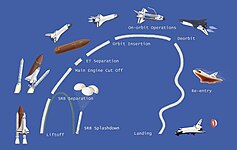
Mission profile. Left: launch, top: orbit (cargo bay open), right: reentry and landing
Its major components were a rocket plane orbiter with an external fuel tank and two solid fuel launch rockets at its side. The external tank, which was bigger than the spacecraft itself, was the only component that was not reused. The shuttle could orbit in altitudes of 185 – 643 km (115 – 400 miles)and carry a maximum payload (to low orbit) of 24,400 kg (54,000 lb).[58] Missions could last from 5 to 17 days and crews could be from 2 to 8 astronauts.[57]
On 20 missions 1983–1998 the Space Shuttle carried Spacelab a space laboratory designed in cooperation with ESA. It was never deployed into orbit but was mounted to the Space Shuttle and went up and down with it on each mission.Another famous line of missions were the launch and later successful repair of the Hubble space telescope 1990 and 1993
In 1995 Russian-American interaction resumed with the Shuttle-Mir missions (1995–1998). Once more an American vehicle docked with a Russian craft, this time a full-fledged space station. This cooperation has continued to 2011, with Russia and the United States the two biggest partners in the largest space station ever built: the International Space Station (ISS). The strength of their cooperation on this project was even more evident when NASA began relying on Russian launch vehicles to service the ISS during the two-year grounding of the shuttle fleet following the 2003 Space Shuttle Columbia disaster.
The shuttle fleet lost two orbiters and 14 astronauts in two disasters: Challenger in 1986, and Columbia in 2003. While the 1986 loss was mitigated by building the Space Shuttle Endeavour from replacement parts, NASA did not build another orbiter to replace the second loss.NASA's Space Shuttle program had 135 missions when the program ended with the successful landing of the Space Shuttle Atlantis at the Kennedy Space Center on July 21, 2011. The program spanned 30 years with over 300 astronauts sent into space.
International Space Station (1998–)
Main article: International Space Station
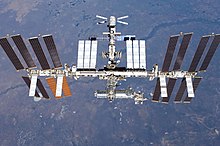
As mentioned it is a joint project between the five participating space agencies, NASA, the Russian RKA, the Japanese JAXA, the European ESA, and the Canadian CSA.The ownership and use of the space station is established in intergovernmental treaties and agreements which divide the station into two areas and allow Russia to retain full ownership of the Russian Orbital Segment,with the US Segment allocated between the other international partners.The station is serviced by Soyuz and Progress spacecraft, the Automated Transfer Vehicle, and the H-II Transfer Vehicle and has been visited by astronauts and cosmonauts from 15 different nations.The Space Shuttle, before its retirement was also used for cargo and crew transfer.
In 2012, it is expected that the American Commercial Resupply Service vehicles, the SpaceX Dragon and the Orbital Sciences' Cygnus, will begin to service the space station with cargo.
On February 1st, 2010, the American Commercial Crew Development program was initiated with the purpose of creating commercially operated spacecraft capable of delivering crew to the ISS.These spacecraft are expected to become operational in the mid 2010s.
Unmanned missions (1958–)
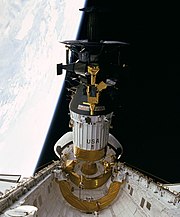
Main article: Unmanned NASA missions
More than 1,000 unmanned missions have been designed to explore the earth and parts of the solar system.Apart from exploration also communication satellites have been launched by NASA.The missions have been launched directly from earth or by space
shuttle, which again could launch the satellite itself or a vehicle
containing the satellite.The first mission was Explorer 1, which started as an ABMA/JPL project during the early space race. It was launched in January 1958, two month after Sputnik. At the creation of NASA it was transferred to this agency and still continues to this day (2011). Its missions have been focusing on the Earth and the Sun measuring among others magnetic fields and solar wind.A more recent Earth mission, not related to the Explorer program, was the Hubble telescope, which as mentioned above was brought into orbit in 1990.
The closest planets Mars, Venus and Mercury have been the goal of at least 4 programs. The first was Mariner in the 1960s and ‘70s, which visited all three of them. Mariner was also the first to make a planetary flyby, to take the first pictures from another planet, the first planetary orbiter, and the first to make a gravity assist maneuver. This is a technique where the satellite takes advantage of the gravity and velocity of planets to reach its destination.
The first successful landing on Mars was made by Viking I in 1976. 20 years later a rover was landed on Mars by Mars Pathfinder.
Outside Mars, Jupiter was first visited by Pioneer 10 in 1973. More than 20 years later Galileo sent a probe into the planets’ atmosphere. The first spacecraft to leave the solar system was Pioneer 10 in 1983. At a time it was the most distant spacecraft, but it is now passed by Voyager 2.
Both the Pioneer and the Voyager program carries messages from the Earth to extraterrestrial life. A problem with far space travel is communication. For instance, at present it takes about 3 hours for a radio signal to reach the New Horizon spacecraft at a point more than half way to Pluto. Contact with Pioneer 10 was lost in 2003.
On 26 November 2011, NASA's Mars Science Laboratory mission was successfully launched for Mars. The mission is scheduled to land the robotic "Curiosity" rover on the surface of Mars in August 2012, whereupon the rover will search for evidence of past or present life on Mars.
Recent and planned activities
 |
 |
|
The SpaceX Dragon is one the CCDEV 2 winners, it is shown here being readied for a COTS demonstration mission
|
The Orion spacecraft is intended to be used for beyond low Earth orbit missions, shown here is the ground test article
|
The New Horizons mission to Pluto was launched in 2006 and aiming for Pluto flyby in 2015. The probe received a gravity assist from Jupiter in February 2007, examining some of Jupiter's inner moons and testing on-board instruments during the fly-by. On the horizon of NASA's plans is the MAVEN spacecraft as part of the Mars Scout Program to study the atmosphere of Mars.
On December 4, 2006, NASA announced it was planning a permanent moon base. The goal was to start building the moon base by 2020, and by 2024, have a fully functional base that would allow for crew rotations and in-situ resource utilization. However in 2009, the Augustine Committee found the program to be on a "unsustainable trajectory." In 2010, President Barack Obama halted existing plans, including the Moon base, and directed a generic focus on manned missions to asteroids and Mars, as well as extending support for the International Space Station.
On April 18, 2011, NASA awarded nearly $270 million to four companies to develop U.S. vehicles that could fly astronauts to the ISS as part of the CCDEV 2 program.
In September 2011, NASA announced the start of the Space Launch System program to develop a human-rated heavy lift vehicle. The Space Launch System is intended to launch the Orion Multi-Purpose Crew Vehicle and other elements towards the Moon, an near-Earth asteroids and one day Mars. The Orion MPCV is planned for an unmanned test launch on a Delta IV Heavy rocket around late 2013.
NASA science
Medicine in space
Main article: Space medicine
A variety of large-scale medical studies are being conducted in space via the National Space Biomedical Research Institute (NSBRI). Prominent among these is the Advanced Diagnostic Ultrasound in Microgravity Study in which Astronauts (including former ISS Commanders Leroy Chiao and Gennady Padalka)
perform ultrasound scans under the guidance of remote experts to
diagnose and potentially treat hundreds of medical conditions in space.
Usually, there is no physician onboard the International Space Station
and diagnosis of medical conditions is challenging. In addition,
Astronauts are susceptible to a variety of health risks including
decompression sickness, barotrauma, immunodeficiencies, loss of bone and
muscle, orthostatic intolerance due to volume loss, sleep disturbances,
and radiation injury. Ultrasound
offers a unique opportunity to monitor these conditions in space. This
study's techniques are now being applied to cover professional and
Olympic sports injuries as well as ultrasound performed by non-expert
operators in populations such as medical and high school students. It is
anticipated that remote guided ultrasound will have application on
Earth in emergency and rural care situations, where access to a trained
physician is often rare.Ozone depletion
In the middle of the 20th century[clarification needed] NASA augmented its mission of Earth’s observation and redirected it toward environmental quality. The result was the launch of Earth Observing System (EOS) in 1980s, which was able to monitor one of the global environmental problems—ozone depletion. The first comprehensive worldwide measurements were obtained in 1978 with the Nimbus-7 satellite and NASA scientists at the Goddard Institute for Space Studies.Salt evaporation and energy management
In one of the nation's largest restoration projects, NASA technology helps state and federal government reclaim 15,100 acres (61 km2) of salt evaporation ponds in South San Francisco Bay. Satellite sensors are used by scientists to study the effect of salt evaporation on local ecology.NASA has started Energy Efficiency and Water Conservation Program as an agency-wide program directed to prevent pollution and reduce energy and water utilization. It helps to ensure that NASA meets its federal stewardship responsibilities for the environment.
Earth Science Enterprise
Understanding of natural and human-induced changes on the global environment is the main objective of NASA's Earth Science Enterprise. NASA currently has more than a dozen Earth science spacecraft/instruments in orbit studying all aspects of the Earth system (oceans, land, atmosphere, biosphere, cyrosphere), with several more planned for launch in the next few years.NASA is working in cooperation with National Renewable Energy Laboratory (NREL). The goal is to produce worldwide solar resource maps with great local detail. NASA was also one of the main participants in the evaluation innovative technologies for the clean up of the sources for dense non-aqueous phase liquids (DNAPLs). On April 6, 1999, the agency signed The Memorandum of Agreement (MOA) along with the United States Environmental Protection Agency, DOE, and USAF authorizing all the above organizations to conduct necessary tests at the John F. Kennedy Space center. The main purpose was to evaluate two innovative in-situ remediation technologies, thermal removal and oxidation destruction of DNAPLs. National Space Agency made a partnership with Military Services and Defense Contract Management Agency named the “Joint Group on Pollution Prevention”. The group is working on reduction or elimination of hazardous materials or processes.
On May 8, 2003, Environmental Protection Agency recognized NASA as the first federal agency to directly use landfill gas to produce energy at one of its facilities—the Goddard Space Flight Center, Greenbelt, Maryland.
Facilities
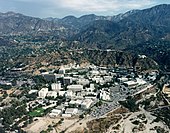 |
| Add caption |
Jet Propulsion Laboratory complex in Pasadena, California
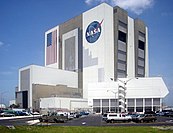
Vehicle Assembly and Launch Control at Kennedy Space Center
Main article: NASA facilities
NASA's facilities are research, construction and communication
centers to help its missions. Some facilities serve more than one
application for historic or administrative reasons. NASA also operates a
short-line railroad at the Kennedy Space Center and own special aircrafts for instance two Boeing 747 which were used for transport of the Space Shuttle orbiter.John F. Kennedy Space Center (KSC), is one of the best-known NASA facilities. It has been the launch site for every United States human space flight since 1968. Although such flights are currently on pause, KSC continues to manage and operate unmanned rocket launch facilities for America's civilian space program from three pads at the adjoining Cape Canaveral Air Force Station.
Another major facility is Marshall Space Flight Center in Huntsville, Alabama at which the Saturn 5 rocket and Skylab were developed. The JPL, mentioned above, was together with ABMA one of the agencies behind Explorer 1, the first American space mission.

Charles F. Bolden, Jr., Administrator

Lori Garver, Deputy Administrator
Leadership
Main article: List of NASA Administrators
The administrator
is the highest-ranking NASA official and serves as the senior space
science adviser to the President of the United States. The
administration is located at NASA Headquarters in Washington, DC and provides overall guidance and direction to the agency.The first Administrator was Dr. T. Keith Glennan; during his term he brought together the disparate projects in space development research in the US.
Some administrators like Richard H. Truly (administrator 1989–1992) have been astronauts themselves. Among others he piloted Space Shuttle Columbia in 1981 on its second flight and later supervised the rebuilding of the shuttle program after the disaster of Challenger in 1986
On May 24, 2009, President Obama announced the nomination of Charles Bolden as NASA administrator, and Lori Garver as deputy administrator. Bolden was confirmed by the US Senate on July 15, 2009 as the twelfth administrator of NASA. Lori Garver was confirmed as NASA's deputy administrator.
Budget
Main article: Budget of NASA
Public perception of the NASA budget may be very different from reality and has been the subject of controversy since the agency's creation.A 1997 poll reported that Americans had an average estimate of 20% for NASA's share of the federal budget. In reality, NASA's budget has been between 0.5% and 1% from the late 1960s on.
NASA budget briefly peaked at over 4% of the federal budget in the mid-1960s during the build up to the Apollo program.



No comments:
Post a Comment